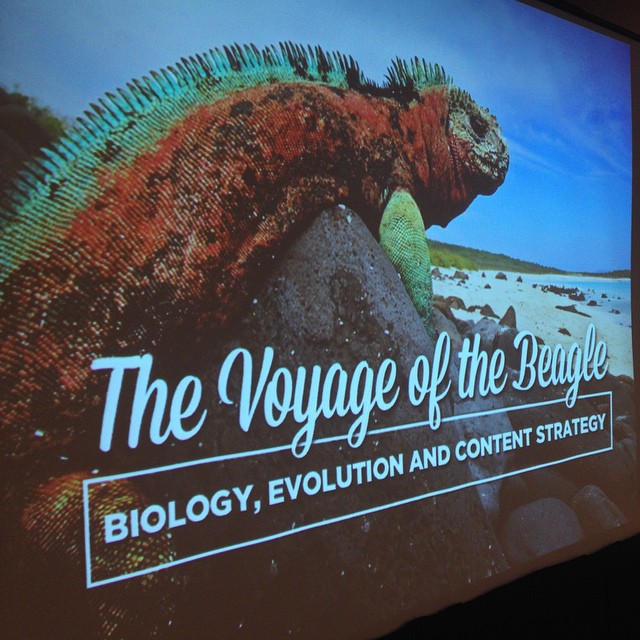The World Wide Web is governed by similar principles those laid out by Charles Darwin in his Theory of Evolution. And mastering certain evolutionary tricks and strategies can lead to great results for your website.
That’s the message Jeff Stevens, of University of Florida Health (UF Health), gave to a packed room at HighEdWeb 14 Tuesday during his session “The Voyage of the Beagle: Biology, Evolution and Content Strategy. Stevens (Full disclosure: Jeff’s also one of Link’s art directors. Fuller disclosure: He’s awesome.) examined the evolution of the website for UF Health, a massive system that includes, as their site notes “six health colleges, seven research institutes and centers, two teaching hospitals, two specialty hospitals and a host of physician medical practices and outpatient services throughout north central and northeast Florida.”
“All websites also share DNA – their code,” Stevens said. The evolution on the web comes from artificial means, rather than natural selection, but the principles remain the same.
One such instance: in biological evolutionary theory, the concept of koinophilia is the idea that an individual in the species will seek a mate based on features that it doesn’t find unusual or peculiar.
Websites to that too, Stevens said.
“Often we make decisions on how we’ll build a website based on looking what other sites look like,” he said. “Netflix and Hulu make decisions based off of each other’s designs, for instance.”
At UF, the web team at the health center ended up experiencing their own version of speciation – the idea where animals split off into different versions of the same animal. The UF Health brand had grown to be a distinct brand from the school’s overall brand. The UF Health web team was hoping to experience gradualism, the slow, steady version of that change that occurs over time. But instead, events such as the appointment of a new chief executive led to saltation, an environmental change that provokes much more rapid evolution. The new president want to bring the patient facing and academic facing sides of the system closer together. That lead to a long project to merge disparate parts of the system’s web presences together. Drupal, WordPress and other systems had to be brought together to created a better experience for both patients, employees and other users.
The team at UF Health even relied on taxonomy – in this case web taxonomy, not the animal taxonomy developed by the biologist Linneaus – to build the menu, categories and tags that would bring a mountain range of information together.
“If you’re building a taxonomy, take time to plan to it ahead of time,” Stevens said. Simpler is better, he said. Instead of talking about an award-winning program that studied cancer in dogs, UF was talking about canine oncology.
“Who was searching for canine oncology instead of dog cancer?” Stevens asked rhetorically.
Tools that UF Health used began to gain an evolutionary advantage: other part of the UF system started to adopt them.
After introducing the new site online appointment requests increased 406%
Average time on site for patients was 600% higher than average user.
“They’re going in and looking at information to make decisions about their health,” Stevens said.
And, proving that evolution rewards good adaptations, 10 of UF’s 16 colleges now use the system created by Stevens and his colleagues.
The new system is dominating its evolutionary niche.
“We will continue to evolve,” Stevens noted.

